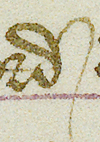|
| A |
 | Usage: quaking
note the purple ruling.Single compartment 'a' used by this scribe. |  | Usage: al |
 | Usage: And
one of several upper case 'A's. |  | Usage: And |
|
| D |
 | Usage: And
there are many hairline strokes attached to final letters of words. These contrast with the thickened descenders of 's' and 'f'. |  | Usage: word
looped 'd' and unlooped 'd' are both used by the scribe. Where the looped 'd' is used, mainly in final position, it is common for the loop to extend back over several of the preceding letters. |
 | Usage: Drily
initial letters of lines tipped with red ink. |  | Usage: Pardoner
'd' in the display script of the scribe in the rubric. |
|
| G |
 | Usage: grace
secretary tailed 'g'. The head of the right-hand stroke stands above the level of the left. |  | Usage: during
'g' in final position with trailing otiose tag extension. |
 | Usage: thing
the 'ing' in this word is a correction. Is it by another scribe who uses a hooked form of 'g', whereas that graph is not in evidence in this manuscript? |  | Usage: Prologo
one of the only hooked 'g's in the manuscript that has been found so far in the incipit to the Shipman's Tale. It may be a feature of the scribe's display hand. |
|
| H |
 | Usage: hir
the limb of 'h' is short and compact. It either finishes on the line or just beneath. |  | Usage: This
second letter after the upper case letter which begins the line. |
 | Usage: Hath
upper case 'H' tipped with red ink. |  | Usage: half
on the first folio of the manuscript with elaborate decorated border, the scribe employs many more hairline strokes. It is perhaps for this reason that almost every lower case 'h' on this folio has an extended hairline tail descending below the letter and turned to the right. The impact of these hairline strokes in the script complements the border decoration. |
|
| R |
 | Usage: riden
frequent use of 'z'-shaped 'r' which alternates with modern 'r' and is used in all positions. The graph frequently has an otiose stroke attached descending from the lower left. |  | Usage: grace
modern 'r' has a curved stem. The shoulder is joined by a hairline to the stem. |
 | Usage: lodesterre |  | Usage: verri
double 'z'-shaped 'r'. |
|
| S |
 | Usage: is
kidney-shaped 's' always used in final position, often with hairline stroke attached. |  | Usage: shede
the shaft of long 's' is thick. The headstroke is usually finer than in the example shown here. |
 | Usage: So
an upper case 'S' tipped with red. |  | Usage: Sic
horned additions in the scribe's display script. |
|
| W |
 | Usage: write
the regular lower case letter with looped head. |  | Usage: Whan
at the beginning of a line so probably an upper case 'W' which is the same as the lower case letter. |
 | Usage: Wich
an alternative cursive form of 'W' at the beginning of a line as the upper case graph. |  | Usage: whilom
'w' in the elongated letters of the display script which the scribe employs throughout the manuscript for the first line of tales and prologues. |
|
| Y |
 | Usage: paciently
most 'y's on this folio are dotted and have wavy tails. |  | Usage: my |
 | Usage: story
on some folios, the tail of 'y' is much finer and gives the impression of another otiose stroke. |  | Usage: they
an example taken from the first folio. Here the tail of 'y' becomes another hairline decorative stroke, as was remarked about the tail of 'h'. On the opening folio, the tails of 'y' are fine and loosely curved. There are few wavy tails in evidence, so a deliberate choice by the scribe. |
|
| Yogh |
 | Usage: Riȝt
yogh is used infrequently. |  | Usage: niȝt |
 | Usage: ȝephirus
yogh used for modern 'z'. | | |
|
| Upper Case Letters |
 | Usage: Riȝt |  | Usage: Vnto |
 | Usage: Ne |  | Usage: Pardoner
upper case 'P' with hooked addition at the head and at the lower part of what purports to be the lobe. |
|
| Long s and f |
 | Usage: muse |  | Usage: lodesterre |
 | Usage: for |  | Usage: of
trailing otiose stroke from the 'f' in final position. |













































